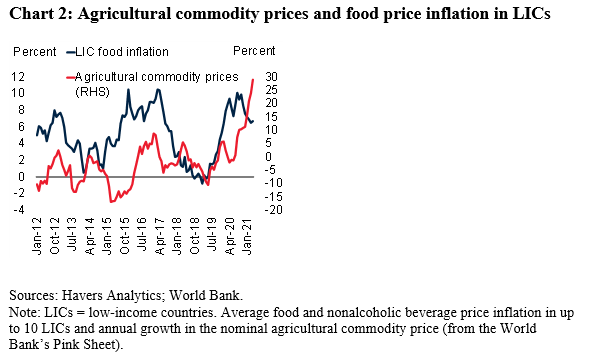Rising inflation amid the post-pandemic economic recovery and climbing food prices could aggravate food insecurity in low-income countries (LICs), which has already been driven higher by conflict, adverse weather, and pandemic-related disruption. However, to mitigate the impact on vulnerable populations, policymakers should focus on social protection measures rather than export restrictions or price controls – which may only serve to raise global food prices. Assistance may be required to support the provision of such safety nets and international cooperation may be needed to sustain the resilience of the local food supply.
LICs have historically struggled with high inflation relative to other economies, a product of less developed monetary policy frameworks and financial systems, high exposure to volatile commodity prices, and the influence of fiscal objectives in monetary policy. However, through a combination of good luck and improving global and domestic monetary policy frameworks, inflation had fallen to 3.4 percent in 2019, well below its high of 25 percent in 1994. In the current environment, although inflation is rising, it remains well below previous highs. Nevertheless, further rises in inflation, particularly where driven by higher food prices, could pose an additional threat to the world’s poorest, alongside significant economic damage from the pandemic.
A rise in inflation in LICs during the pandemic
Whereas inflation in advanced economies and emerging market and developing economies (EMDEs) fell after the widespread implementation of restrictions on movement across the world, median inflation in LICs actually rose, from 3.9 percent in January 2020 to 5.6 percent in April 2020. The pickup in inflation over this period affected the majority of LICs and ranged up to 5 percentage points. Much of the increase in inflation in LICs was a result of rising food prices. As a result, LIC inflation for 2020 as a whole increased by 1.1 percentage points from the previous year.
Further near-term upside pressure from rising food prices
In LICs, food accounts for about half of consumption baskets and 20 percent of goods imports, a larger share than in other EMDEs. As a result, the path of global agricultural commodity prices has a bearing on LIC inflation. Agricultural commodity prices have grown rapidly in 2021, and as of April 2021 were 29 percent higher than a year ago, the fastest price increase since 2011. The gradual and incomplete pass-through from commodity prices to domestic food price inflation, reflecting the importance of local market conditions and costs in addition to global prices, suggests inflation will continue to climb in LICs in the remainder of this year. At the same time, absent other shocks, the stabilization of agricultural prices later in 2021 and the expected weak recovery in output in LICs may allow for a slowdown in inflation in 2022 and beyond.
Risks to food security
Rising food prices and aggregate inflation are likely to compound food insecurity in LICs, which surged in 2020 and 2021 as a result of lost income and disruption due to the pandemic, and ongoing or intensifying conflicts and political instability. The number of people experiencing a food shortage crisis increased from 135 million in 2019 to about 165 million people in 2020, according to data from the Food Security Information Network and the Global Network Against Food Crises.
Policies
High inflation, driven by rising food prices, COVID-related supply disruptions, and to some extent, currency depreciation, may tip more people into poverty and food insecurity in LICs.
The use of export restrictions, subsidies, or price controls to reduce the burden of rising food prices may appear attractive but risks adding further upward pressure on global agricultural prices. Instead, targeted social protection measures, such as cash and food transfers, may mitigate the impacts of the pandemic on food security with fewer adverse impacts on global food prices. LICs may face larger challenges in delivering and developing sources of revenue for these transfers, requiring technical and financial assistance. International support for improved logistical capabilities and to ensure the climate resilience of local food supply can contribute to both near and longer-term food security in LICs.






Join the Conversation